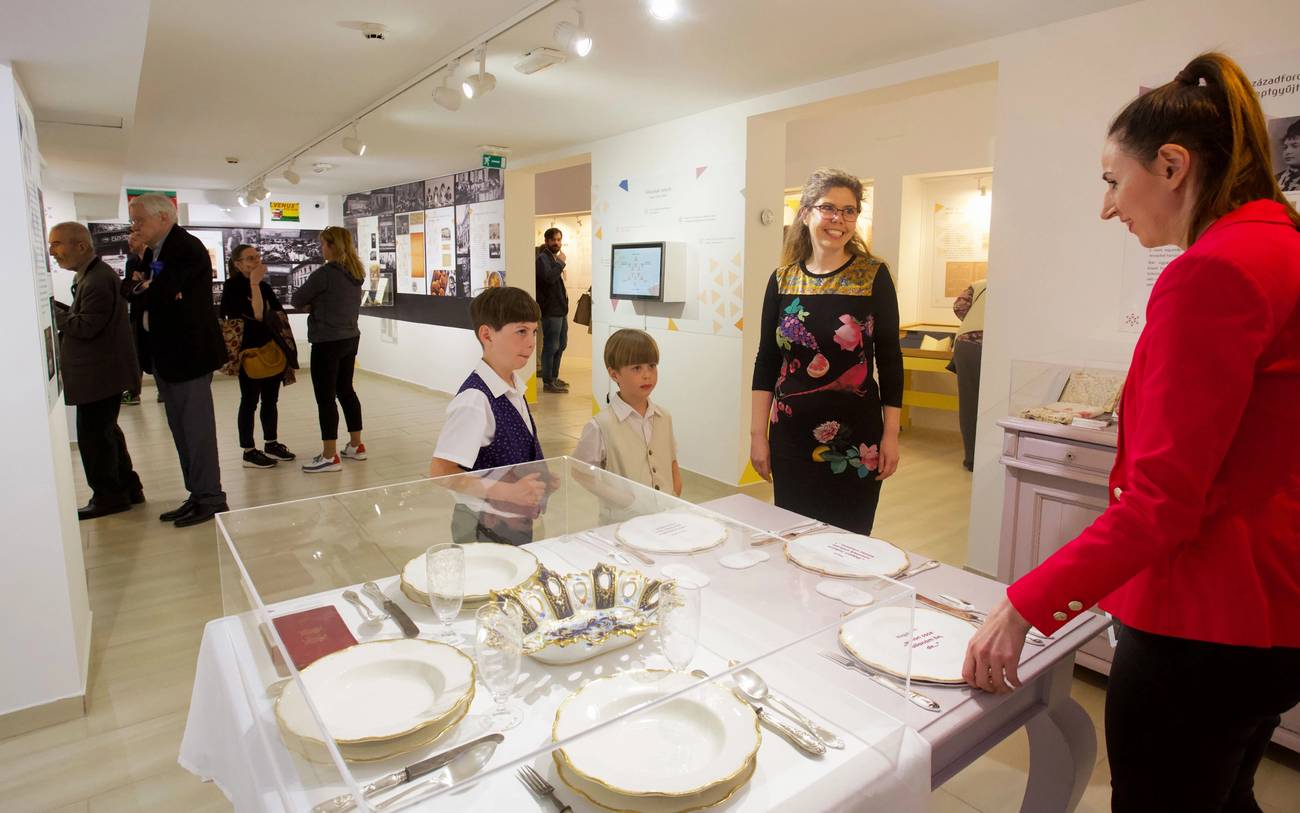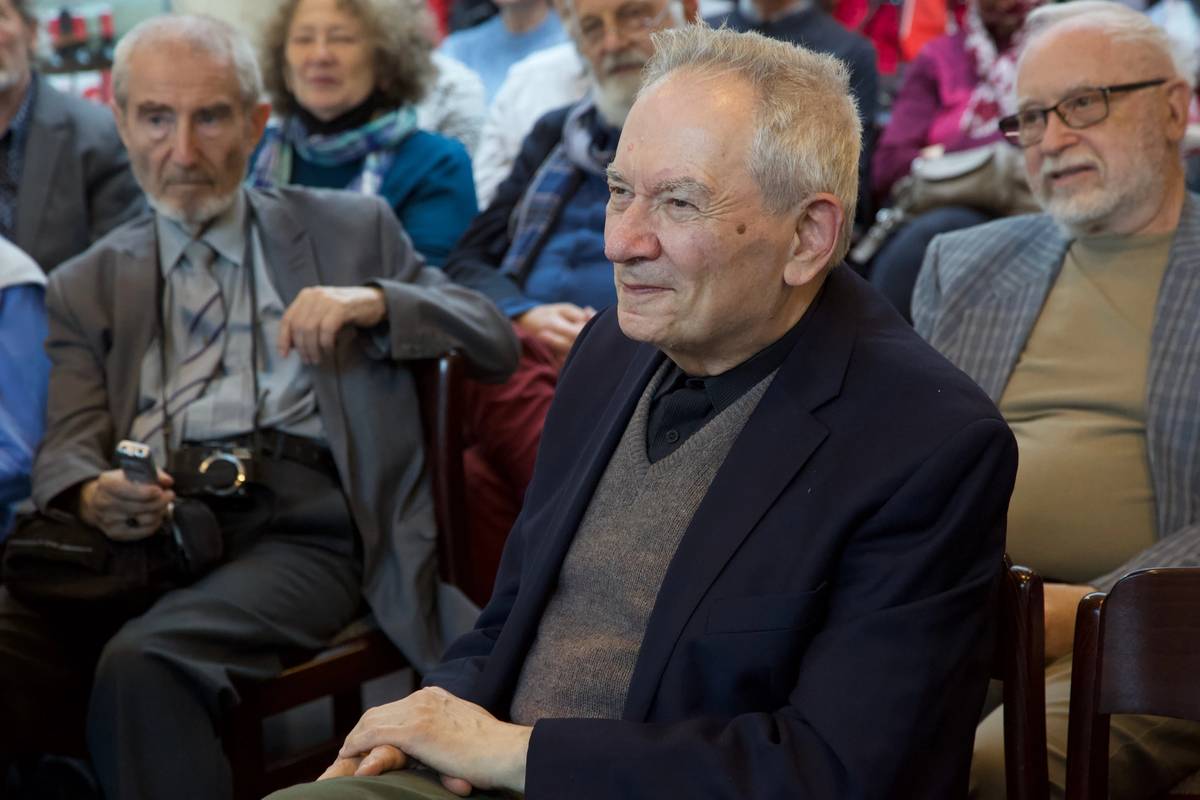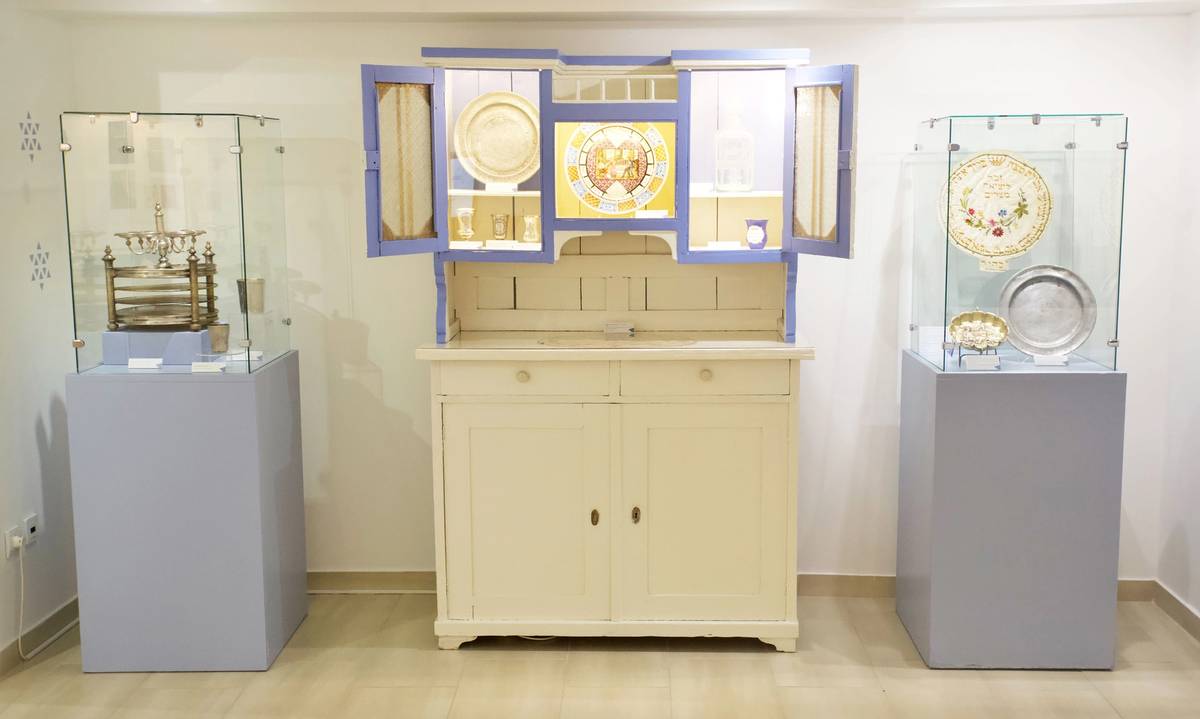Putting Jewish Food in Context
In a new museum exhibit in Budapest, András Koerner examines what Jews had historically eaten—and why



Budapest native András Koerner is an expert on his country’s Jewish food—not just what Jews ate historically, but the where, when, and why as well. Koerner, 81, retired from his career as an architect in 2003, and has since devoted his time to meticulously documenting and uncovering Jewish Hungarian life and foodways prior to the Holocaust—first through a series of books, and now through a museum exhibit in his hometown.
Koerner’s exhibition Jó Lesz a Bólesz, which documents the history of Jewish Hungarian cuisine, is on display through November at Budapest’s Hungarian Museum of Trade and Tourism in the Óbuda neighborhood, once home to the region’s largest Jewish community in the late 17th and early 18th centuries. The name of the exhibit is a Hungarian pun that roughly translates to “the bólesz will be good”—bólesz being a snail-shaped yeast pastry with walnuts, raisins, and cinnamon historically tied to the Jewish Hungarian community. The dish, Koerner explains, dates back to Sephardic Jews who fled to Holland following the Spanish Inquisition. These Sephardic bakers were responsible for the creation of the Dutch pastry zeeuwse bolus, which became bólesz when a Hungarian Jewish traveler tried to bake something similar after returning from Holland in the 19th century. “It represents one of the very few instances of Sephardic influence in the overwhelmingly Ashkenazi character of Hungarian Jewish cuisine,” Koerner said.
Before the COVID-19 pandemic, Koerner returned from New York City, where he currently lives, to his hometown of Budapest two or three times a year to visit his brother and sister and to do research for his books. The launch of the exhibition spurred his monthlong visit this past April to help finalize its presentation. There was also the matter of a book party to celebrate the publication of his latest book, also titled Jó Lesz a Bólesz, on the history of some early Jewish cookbooks. The English translation Early Jewish Cookbooks: Essays on the History of Hungarian Jewish Gastronomy hits shelves this summer.
The museum exhibit opened in April. “I believe this is the first comprehensive historical and chronological exhibition that has existed about Jewish culinary culture of any country,” Koerner said, noting the various 19th-century artifacts and recipe manuscripts he donated to the museum after inheriting them from his ancestors. “They represent the most comprehensive surviving group of 19th-century culinary artifacts and manuscripts from a Jewish family in Hungary.”
Róbert Török, director of the Hungarian Museum of Trade and Tourism, added: “The subject András focused on has been little researched until now and is not widely known. Therefore, in our museum showcasing ‘everyday life,’ we sought to present it in a way that makes learning about the new research an engaging experience for our visitors.”
I first met Koerner at Breads Bakery near Central Park in New York City last May after reading his book Jewish Cuisine in Hungary, winner of the 2019 National Jewish Book Award for Food Writing & Cookbooks. Over bites of chocolate babka we discussed the evolution of Ashkenazi Jewish cuisine, namely his belief that it’s the context that defines Jewish food.
From his research, he learned that Jews ate some unique specialties for the holidays, but everyday meals consisted of virtually the same dishes eaten by non-Jewish Hungarians—albeit with changes made by those who observe the laws of kashrut: For example, a Jewish chicken paprikash would skip the sour cream to avoid mixing dairy and meat. Dishes he does credit Jews with introducing to the Hungarian diet are matzo ball soup, cholent, and flódni––a four-layer pastry with different fillings like poppy seed, walnuts, plum jam, and apples.
When I spotted him in April at the new exhibit in Budapest, Koerner was just as I remembered him from our meeting in New York: his beaming smile, polite handshake, and frequent, enunciated belly laugh as if he’s actually pronouncing the words, “Ha, ha.”
The exhibition begins with a large wall of printed black-and-white photographs depicting pre-Holocaust life in the former Hungarian empire. There’s a Jewish boy with sidelocks stretching from underneath his yarmulke standing barefoot on cobblestones, and a collection of photos showing traditional shtetl and family life.

But Koerner pointed out the family portraits. They look typical of the 19th century. In one, the parents, dressed in black, sit in the foreground with their three daughters dressed in white standing behind them. Koerner pointed to the woman in the upper right. “That’s my grandmother,” he said. Koerner’s family heirlooms make up a substantial portion of the exhibition.
There’s family china and cutlery, his great-grandmother’s recipe scribblings in German Fraktur handwriting, and painted portraits of his great-great-grandparents. These items give visitors a taste of middle-class Jewish Hungarian family life prior to the Holocaust; items that Koerner believes only survived because his grandmother, Edit Berger, took them with her to the United States when she immigrated in 1946 to be with her daughter and to receive medical care that was unavailable in postwar Hungary.
The then 4-year-old Koerner, however, stayed with his parents in Hungary after surviving the Budapest ghetto.
We headed over to Rosenstein Restaurant for an early dinner and to continue the conversation about his life. Rosenstein, run by the patriarch 79-year-old Tibor Rosenstein and his son Robi, is something of a bucket-list visit for Jewish food nerds. Opened in 1996, it has the air of fine dining without the pretentiousness or price tag. Not that Koerner would know much about the price tag. “He never lets me pay,” Koerner said with a laugh. “It’s tremendously frustrating. I feel bad!”
Rosenstein and Koerner struck up their friendship 15 years ago. “We met when we cooked for the food show in New York,” Rosenstein said, with Koerner translating. Rosenstein didn’t elaborate much on their friendship, perhaps due to the awkwardness of relying on Koerner to translate how he feels about him, but it was clear the two have developed a close bond over the past two decades.
Koerner bragged about his friend like a brother, and boasted about the restaurant’s success over the years. It’s developed an enviable reputation through word of mouth, drawing visitors and regulars alike to the otherwise quiet residential streets a block away from the city’s main train station, Keleti. Photos of Rosenstein grinning with his arm around celebrities like Robert De Niro and Helen Mirren adorn the wall near the entrance.
“The kitchen brought us together,” said Koerner, who’s since used some of Rosenstein’s own heirlooms in his research and writing. “I used his grandmother’s cookbook, which was a handwritten collection of recipes and an example of the cuisine of Jewish families that no longer kept kosher.”
Those recipes heavily influence the menu at Rosenstein, including their eponymous cookbook, The Rosensteins’ Cookbook, published in 2017 with the tagline inspired by Tibor’s grandmother: “All good things are kosher.”
“We prepare Jewish food and have a Jewish kitchen, but we are not kosher,” said Rosenstein, sharing casual bites of matzo with Koerner. “My grandmother said, ‘Everything that is good is kosher.’ So to us everything that is good is kosher.”
Koerner explained that Rosenstein became a cook because of his grandmother. Both of Rosenstein’s parents were killed in Auschwitz, so he grew up in poverty with his sister living at their grandmother’s. Considering the scarcity of food, she told the young Rosenstein to become a cook so he would never have to worry about being hungry.
The rest is history. Despite living his dream and generally being an optimist, the history of his family continues to weigh heavily on Rosenstein’s mind.
“I cannot forget that my parents were murdered,” said Rosenstein, adding another thought that continues to plague him no matter how successful the business is: “How long can Jews exist without real problems?”
Koerner shared what he remembered of the Budpadest ghetto, describing his memory as separate snapshots.
“I thought that the yellow star was really wonderful and beautiful. Although it was not mandatory for young children, I threw a fit that I should wear it, too,” he said. “I perceived it like a medal or some prize. Not as a matter of shame.”
Of course Koerner was too young at the time to understand the true purpose of the yellow star, which explains why he “absolutely insisted” that his doll should have one, too.
Fortunately, Koerner’s family survived. But a Christian family occupied their home and were unwilling to return it after the war. As a result, his family had no choice but to live in one of Budapest’s infamous Yellow Star Houses. Koerner and his family had previously been forced to live there during the war before he was moved to the central ghetto of Budapest until Soviet liberation in January 1945. The house where he grew up in is located in the Újlipótváros neighborhood, a historically middle-class Jewish neighborhood where Koerner continues to live whenever he’s in Budapest.
Koerner’s father was an architect. He had pointed out a couple of his father’s buildings while we were waiting for the bus near the exhibition. “They’re not that great, so I’m not terribly proud of them,” he said, punctuating with a self-deprecating laugh.
Koerner followed in his father’s footsteps, becoming an architect himself. He tried twice in the 1950s to escape communist Hungary but was caught on both occasions. Eventually he met an American woman while studying in the Austrian village of Alpach while attending the Europa Forum, an annual summer school for young people from around the world. His future bride was there with her parents for summer vacation.
When they decided to get married, he asked if she preferred living in the United States or Hungary. Life in communist Hungary didn’t appeal, so they moved to New York City in September 1967.
Despite surviving the Holocaust, Koerner says his Jewish heritage never played a role in his life in the immediate postwar period. His family celebrated Christian holidays, like Christmas and Easter, and never went to synagogue. “I instinctively tried to keep my distance in my teens from my Jewish origin and religion,” he said. “I knew practically nothing about it. I had no idea about the holidays and felt that my Jewish background did not deserve much attention.”
It wasn’t until he reached middle age, settled in New York City with two kids, that he decided to explore his heritage.
“I had a very bad relationship with my mother,” he said. “When she got old, I thought that working on a project together with her would somehow bring us closer together.”
Because Koerner’s emigration was considered illegal by Hungary’s communist government, he was unable to return to Budapest until he became a U.S. citizen in 1973 and was released from his Hungarian citizenship. That’s when his regular visits back to Budapest began. During one of his visits in 1983, he started to ask his mother about her life and recorded their conversation. She began with her early childhood and told stories of being raised by her religious grandmother.
“She started to talk about how they celebrated the holidays and how they ran the household,” he said. Koerner’s interest was piqued. His mother wasn’t particularly interested in exploring their Jewishness or why they did things the way they did, like separate dairy from meat, but Koerner wanted to learn more. “I started reading up on it and that was it.”
Koerner made annual return visits to Budapest over the next seven years, recording hours of memories from his mother. He learned that for the first six years of her life she was raised by her religiously observant grandmother, Therese Berger, in the small town of Moson near the Austrian border. Koerner’s great-grandparents were the last in his family to strictly observe kashrut and Jewish holidays.
Back in New York, Koerner would spend his days working as an architect and nights transcribing the recordings of his mother all the while studying Jewish traditions, history, and culture. This led to his first book, A Taste of the Past, published in 2003, when he was 63. Using his interviews, Koerner takes readers back to 19th-century Jewish Hungary and to the home of his great-grandmother. There are chickens in the courtyard and pantries bursting with pickles and other preserves leading up to prepping Shabbat dinners. The book also includes recipes dating back to 1869 written by his great-grandmother in the German Fraktur handwriting also on display alongside her 1878 Haggadah at the Jó Lesz a Bólesz exhibition. Koerner explains that these recipes represent the earliest written accounts in Hungary of Ashkenazi Jewish staples, like matzo ball soup, cholent, and kugel. The book also includes commentary and instructions from Koerner, who notes that most of the dishes were taken from Christian neighbors and adjusted slightly for kashrut. In one example, Therese keeps her cakes kosher-for-Passover by using ground walnuts or almonds instead of flour to avoid using forbidden leavening agents or chametz.

Koerner’s second book on the topic came out 13 years later––a two-volume project titled How They Lived that documents the everyday lives of Hungarian Jews in the late 19th and early 20th centuries through historical photographs and texts. This was quickly followed by the award-winning Jewish Cuisine in Hungary in 2019. Here Koerner reconstructed the culinary culture of pre-Holocaust Hungarian Jewry. Barbara Kirshenblatt-Gimblett, herself a well-respected scholar of Jewish studies and life, boasts in the preface: “While cookbooks abound, there is no other study that can compare with this book. It is simply the most comprehensive account of a Jewish food culture to date.”
Koerner’s intellectual interests extend beyond Jewish Hungarian culture. Between his first two books, in 2008 he published a book about Andor Weininger, a Hungarian artist and architect who was active in German Bauhaus. In 2020, he published a Hungarian book, Költők a kabaréban, that discusses the contributions of select poets to the 20th-century evolution of Hungarian cabaret. Most recently he turned his attention back to Hungarian Jewish culinary history with his latest, Early Jewish Cookbooks––a volume of seven essays that touches on many of the topics highlighted in the exhibit, such as the world’s first cookbook printed in Hebrew letters, and the history of bólesz.
Despite Koerner’s deep, later-in-life interest in his Jewish heritage and reconstructing pre-Holocaust Jewish life, he has not taken up attending synagogue or celebrating Jewish holidays unless his children invite him over to be with his grandkids for the three they celebrate: Rosh Hashanah, Yom Kippur, and Passover.
“It’s three more than I celebrate,” he said with a smile between bites of “Jewish egg”––a chopped egg spread served as an appetizer with bread.
Koerner said he doesn’t believe in God and feels that he would just be going through the motions to celebrate Jewish holidays. “Yes, I’m part of the culture, but I think I can be part of the culture without actually going through the rituals,” he said. “It’s a very personal choice and I’m sure other people feel differently.”
That said, he understands why younger generations are more intensely exploring their family ancestries and reclaiming the traditions in a way he hasn’t. “It gives them satisfaction to somehow experience their roots,” he said. “It’s part of modern life. The ideologies receded and people are now looking for anchors and religion is an important part, for sure.”
Koerner shows no signs of slowing down. “Since I started my second career so late, I have felt that I should hurry with my work,” he said. “I cannot know how long I will have the mental and physical capacity necessary for it.”
Even after completing the Hungarian and English versions of his latest book, he continued researching and started work on his next project: an essay about the gastronomic writings of the Hungarian-born Austrian writer Moritz Gottlieb Saphir, who was the world’s first food writer of Jewish cuisine.
“I’m not sure what motivates me. Perhaps selfishness, since I tremendously enjoy thinking and writing about subjects that for one reason or the other are both intellectually and emotionally close to me,” said Koerner. “Although I treasure the company of my family and friends, I have always needed the structure that only intense and continuous work can give to my days. I am not a particularly social person, and I prefer spending much of my time working. It is a lot more satisfying than feeling bored.”
Joe Baur is a Berlin-based writer, author, and filmmaker from Cleveland.